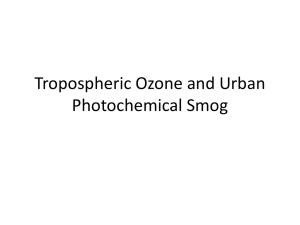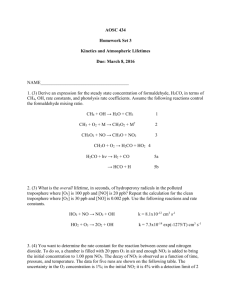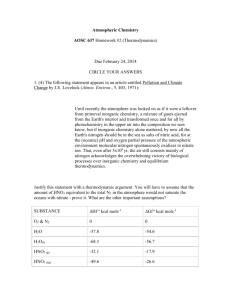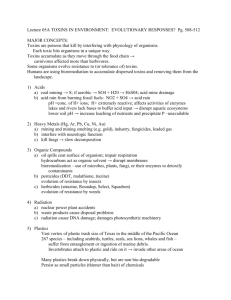Air Quality Engineering (graduate
advertisement
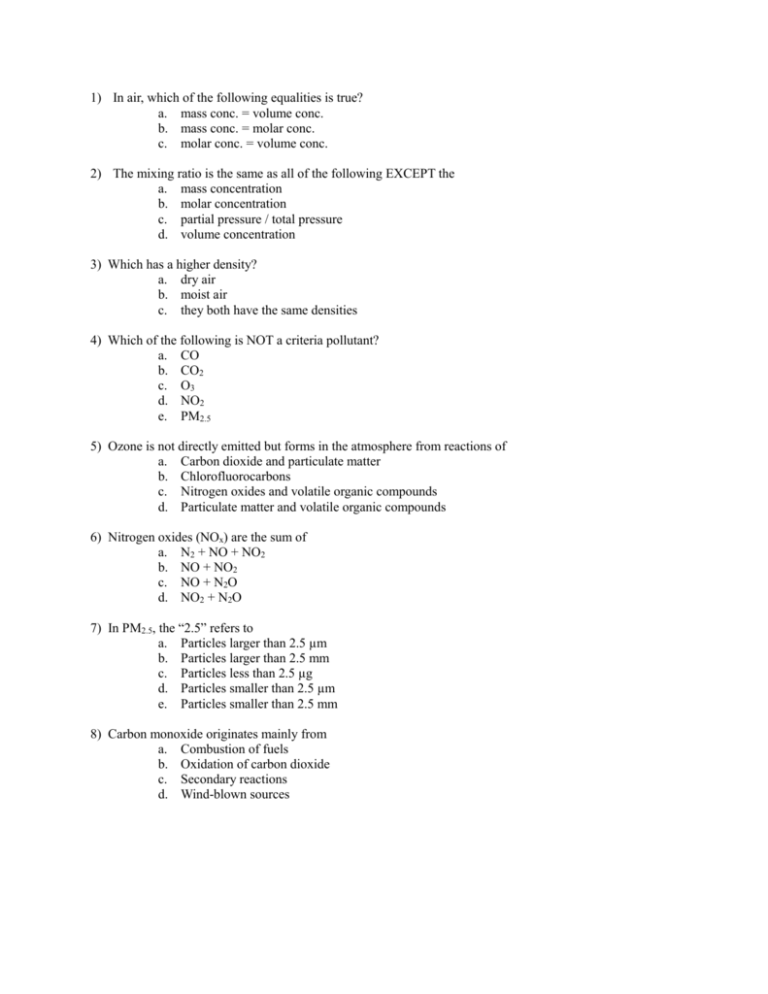
1) In air, which of the following equalities is true?
a. mass conc. = volume conc.
b. mass conc. = molar conc.
c. molar conc. = volume conc.
2) The mixing ratio is the same as all of the following EXCEPT the
a. mass concentration
b. molar concentration
c. partial pressure / total pressure
d. volume concentration
3) Which has a higher density?
a. dry air
b. moist air
c. they both have the same densities
4) Which of the following is NOT a criteria pollutant?
a. CO
b. CO2
c. O3
d. NO2
e. PM2.5
5) Ozone is not directly emitted but forms in the atmosphere from reactions of
a. Carbon dioxide and particulate matter
b. Chlorofluorocarbons
c. Nitrogen oxides and volatile organic compounds
d. Particulate matter and volatile organic compounds
6) Nitrogen oxides (NOx) are the sum of
a. N2 + NO + NO2
b. NO + NO2
c. NO + N2O
d. NO2 + N2O
7) In PM2.5, the “2.5” refers to
a. Particles larger than 2.5 µm
b. Particles larger than 2.5 mm
c. Particles less than 2.5 µg
d. Particles smaller than 2.5 µm
e. Particles smaller than 2.5 mm
8) Carbon monoxide originates mainly from
a. Combustion of fuels
b. Oxidation of carbon dioxide
c. Secondary reactions
d. Wind-blown sources
9) All of the following criteria pollutants cause respiratory irritation EXCEPT
a. Carbon monoxide
b. Ozone
c. Nitrogen dioxide
d. Particulate matter
e. Sulfur dioxide
10) Which criteria pollutant has both primary and secondary sources
a. Carbon monoxide
b. Lead
c. Ozone
d. Particulate matter
e. Sulfur dioxide
11) Average global temperatures have risen by approximately how much over the 20th century?
a. 0 °C
b. 1 °C
c. 3 °C
d. 5 °C
12) Average global temperatures have risen by approximately how much over the 20th century?
a. 0 °C
b. 1 °C
c. 3 °C
d. 5 °C
13) By how much do scientists estimate that global sea level rose in the 20th century?
a. Zero
b. 6-9 inches
c. 3-4 feet
d. 21-23 feet
14) Why is Earth warm enough to support life?
a. Infrared radiation leaving Earth’s surface is absorbed by gases in the lower atmosphere.
b. Radiation from the sun is absorbed by ozone in the stratosphere.
c. X-rays and gamma rays excite gas molecules in the lower atmosphere.
15) Peak solar irradiance occurs in which wavelengths?
a. Infrared
b. Gamma
c. Microwave
d. Visible
16) Peak Earth irradiance occurs in which wavelengths?
a. Infrared
b. Gamma
c. Microwave
d. Visible
17) A greenhouse gas is one that
a. Absorbs shortwave/visible radiation
b. Absorbs longwave/infrared radiation
c. Reflects shortwave/visible radiation
d. Reflects longwave/infrared radiation
18) Which of the following is not a greenhouse gas?
a. Carbon dioxide
b. Chlorofluorocarbons
c. Nitrogen
d. Water vapor
19) Without the atmosphere’s natural greenhouse effect, Earth’s temperature would be
a. 10-20 °C warmer
b. 30-40 °C warmer
c. 10-20 °C cooler
d. 30-40 °C cooler
20) The mass flow rate can be calculated as the product of
a. concentration and velocity
b. concentration and volume flow rate
c. mixing ratio and velocity
d. velocity and volume flow rate
21) Flux may be due to all of the following EXCEPT
a. advection
b. chemical reactions
c. molecular diffusion
d. turbulent diffusion
22) Fick’s law applies to
a. advection
b. chemical reactions
c. molecular diffusion
d. turbulent diffusion
23) d(CV)/dt refers to the rate of change in
a. coefficient of variation
b. flow rate
c. mass
d. volume
24) In the airshed model, which of the following would unquestionably increase the steady-state SO2
concentration?
a. higher emission rate and higher wind speed
b. higher emission rate and lower wind speed
c. lower emission rate and lower wind speed
d. lower emission rate and higher wind speed
25) The Chapman mechanism describes the balance of
a. O, O2, O3
b. O, VOC, NOx
c. O3, CFCs
d. O3, OH, HO2
26) In atmospheric chemistry, a heterogeneous reaction occurs between
a. a compound and M
b. a compound and UV light
c. a gas and a solid
d. a radical and a non-radical
27) Which reaction absorbs most UVB radiation?
a. O2 + h 2 O
b. O + O2 O3
c. O3 + h O2 + O
d. O + O3 2 O2
28) Which of the following is directly responsible for the catalytic destruction of ozone?
a. CCl3F
b. Cl
c. Cl2
d. ClONO2
29) Which of the following is considered a chlorine reservoir?
a. CCl3F
b. Cl
c. Cl2
d. ClONO2
30) Which of the following is a form of active chlorine?
a. CCl3F
b. Cl
c. Cl2
d. ClONO2
31) The severity of the Antarctic ozone hole is worst during the Southern Hemisphere
a. winter
b. spring
c. summer
d. fall
32) In the Southeastern US, the two major constituents of PM2.5 are
a. crustal material and nitrate
b. nitrate and sulfate
c. elemental carbon and organic carbon
d. organic carbon and sulfate
33) Secondary aerosol may be composed of any of the following EXCEPT
a. ammonium
b. elemental carbon
c. nitrate
d. organic carbon
e. sulfate
34) On the basis of number concentration, the majority of particles are found in which mode?
a. Ultrafine
b. Accumulation
c. Coarse
35) On the basis of surface area concentration, the majority of particles are found in which mode?
a. Ultrafine
b. Accumulation
c. Coarse
36) On the basis of mass concentration, the majority of particles are found in which mode?
a. Ultrafine
b. Accumulation
c. Coarse
37) For spherical particles larger than ~5 m, Stokes law describes the
a. buoyancy force
b. drag force
c. slip correction
d. terminal settling velocity
38) The Knudsen number is Kn = 2/Dp. The free-molecular regime corresponds to
a. Kn << 1
b. Kn ~ 1
c. Kn >> 1
39) In the free-molecular regime, the actual settling velocity is
a. slower
b. the same
c. faster
compared to that predicted by Stokes law.
40) For coarse particles, the Cunningham slip-correction coefficient Cc is closest to
a. 0
b. 0.1
c. 1
d. (infinity)
41) Brownian motion is due to
a. the kinetic energy of particles
b. the random motion of air molecules
c. the thermal energy of particles
d. the turbulent motion of air
e. American Gladiators
42) The Stokes number is the ratio of
a. Knudsen number / settling velocity
b. settling velocity / gravitational acceleration
c. stopping distance / settling velocity
d. stopping distance / length of interest
43) In the previous figure, the Stokes number for the particle shown was
a. < 1
b. = 1
c. > 1
44) Which of the following is NOT considered a particle collection mechanism in filters?
a. diffusion
b. gravitational settling
c. impaction
d. interception
45) Which two collection devices are best for ultrafine particles?
a. cyclones and filters
b. cyclones and settling chambers
c. ESPs and filters
d. ESPs and settling chambers
46) For the following reaction, which is the corresponding equilibrium expression?
A+BC+D
a.
b.
c.
d.
K = -k[A][B]
K = +k[C][D]
K = [A][B] / [C][D]
K = [C][D] / [A][B]
47) For the following elementary reaction, which is the corresponding rate expression?
A+BC+D
a.
b.
c.
d.
r = -k[A][B]
r = +k[C][D]
r = [A][B] / [C][D]
r = [C][D] / [A][B]
48) Two hydroperoxy radicals can react together to form hydrogen peroxide as follows:
HO2 + HO2 H2O2 + O2
What expression describes the rate of change of the mole fraction of HO2,
a. -[H2O2][O2] / [HO2]2
b. -½ k [HO2]2
dHO 2
?
c. -2 k [HO2]2
dt
49) What is d[N2O5]/dt in the following mechanism?
O3+ NO2 NO3 + O2
R1
NO3+ NO 2 NO2
R2
NO2+ NO3 N2O5
R3
N2O5 NO2+ NO3
R4
N2O5 (+ H2O) 2 HNO3
R5 (first-order)
a. k3[NO2][NO3]
b. k3[NO2][NO3] -k4[N2O5] - k5[N2O5]
c. -k4[N2O5]
d. -k4[N2O5] - k5[N2O5]
50) What is the characteristic time of N2O5?
O3+ NO2 NO3 + O2
R1
NO3+ NO 2 NO2
R2
NO2+ NO3 N2O5
R3
N2O5 NO2+ NO3
R4
N2O5 (+ H2O) 2 HNO3
R5 (first-order)
a. 1 / {k3[NO2][NO3]}
b. 1 / k4
c. 1 / (k4 + k5)
d. 1 / {(k4 + k5)[N2O5]}
51) Radicals are extremely reactive because they
a. are negatively charged
b. are positively charged
c. have an unpaired electron
d. have a triple bond
52) Radicals are extremely reactive because they
a. are negatively charged
b. are positively charged
c. have an unpaired electron
d. have a triple bond
53) The first step in ozone photolysis O3 + h O(1D) + O2 is
a. chain initiating
b. chain propagating
c. chain terminating
d. none of the above
54) Hydrogen abstraction is always the first step in the reaction of OH with
a. alkanes
b. alkenes
c. aromatics
d. all of the above
55) Addition of OH is always the first step in its reaction with
a. alkanes
b. alkenes
c. aromatics
d. all of the above
56) Ozone is helpful in the ___________ and harmful in the ___________.
a. mesosphere, stratosphere
b. stratosphere, troposphere
c. troposphere, stratosphere
57) In urban areas, ozone tends to peak around
a. midnight
b. the morning rush hour
c. early afternoon
d. the evening rush hour
58) The primary photolytic cycle describes
a. Carbon monoxide and methane chemistry
b. Ozone formation from VOCs
c. Photolysis reactions that produce OH
d. The balance of ozone and NOx
59) What is jNO2?
a. Characteristic lifetime of NO2
b. Equilibrium constant for NO + ½ O2 NO2
c. Henry’s constant for NO2
d. Photolysis rate constant for NO2
60) The assumption that dC/dt ≈ 0 for species whose characteristic lifetime is very small is the
a. Photostationary state relation (PSSR)
b. Primary photolytic cycle
c. Initiation, propagation, and termination model
d. Pseudo-steady-state approximation (PSSA)
61) According to the photostationary state relation (PSSR), O3 is proportional to
a. [NO2]/[NO]
b. [O]/[O2]
c. [OH]/[HO2]
d. [VOC]/[NOx]
62) In the VOC-limited regime, reductions in NOx are likely to result in
a. higher ozone
b. lower ozone
c. unchanged ozone
63) Which of the following reactions is the most permanent termination step, i.e. it does not produce a
temporary reservoir for radicals?
a. HO2 + HO2 H2O2 + O2
b. NO + OH HONO
c. NO2 + OH HNO3
64) Which of the following is NOT true about peroxyacetylnitrate (PAN)?
a. It causes respiratory irritation
b. It is a reservoir for NOx
c. It is an intermediate in VOC chemistry
d. It thermally degrades
65) The ozone production rate equals the rate of which reaction?
a. H + O2 + M HO2 + M
b. HO2 + HO2 H2O2 + O2
c. HO2 + NO NO2 + OH
d. RH + OH R + H2O
66) In the NOx-limited regime, ozone production is
a. linear with [NO]
b. inversely proportional to [NOx]
c. linear with [RH]
d. proportional to [NO]2
67) The ozone production efficiency describes the
a. amount of O3 formed per NOx removed
b. amount of O3 formed per OH radical
c. rate of NOx loss
d. rate of O3 production
68) Which term is typically not considered in a single box model?
a. advection
b. deposition
c. diffusion
d. emissions
e. reactions
69) With entrainment where the mixing depth is growing, how will the concentration change?
a. increase
b. decrease
c. no change
70) Plentiful mixing in the atmosphere is described by what conditions?
a. inversion
b. neutral
c. stable
d. unstable
71) With an inversion, dT/dz is
a. < 0
b. = 0
c. > 0
d. variable
72) The adiabatic lapse rate is approximately
a. 0.1 °C/km
b. 1 °C/km
c. 10 °C/km
d. 100 °C/km
73) What type of inversion is characterized by downward moving air?
a. advective
b. frontal
c. radiation
d. subsidence
74) In an Eulerian three-dimensional model, which term is usually assumed to be zero?
a. advection
b. deposition
c. molecular diffusion
d. dispersion (turbulent diffusion)
75) In pollutant transport models, K-theory describes
a. advection in unstable conditions
b. chemical reaction rates
c. equilibrium chemistry
d. parameterization of turbulence
76) A Lagrangian box model is an example of
a. receptor-oriented modeling
b. source-oriented modeling
c. three-dimensional modeling
77) What is closest to the actual number concentration of particles outside?
a. 1 per cm3 (1 cm-3)
b. 100 cm-3
c. 10,000 cm-3
d. 1,000,000 cm-3
78) What size particle deposits most efficiently in the lungs?
a. 1 nm
b. 10 nm
c. 100 nm
d. 1000 nm
79) On the basis of number concentration, the majority of particles are found in which mode?
a. ultrafine
b. accumulation
c. coarse
80) On the basis of surface area concentration, the majority of particles are found in which mode?
a. ultrafine
b. accumulation
c. coarse
81) On the basis of mass concentration, the majority of particles are found in which mode?
a. ultrafine
b. accumulation
c. coarse
82) For spherical particles larger than ~5 m, Stokes law describes the
a. buoyancy force
b. drag force
c. slip correction
d. terminal settling velocity
83) The Knudsen number is Kn = 2/Dp. The free-molecular regime corresponds to
a. Kn << 1
b. Kn ~ 1
c. Kn >> 1
84) In the free-molecular regime, the actual settling velocity is
a. slower
b. the same
c. faster
compared to that predicted by Stokes law.
85) For large particles, the Cunningham slip-correction coefficient C is closest to
a. 0
b. 0.1
c. 1
d. (infinity)
86) For large particles, the Cunningham slip-correction coefficient C is closest to
a. 0
b. 0.1
c. 1
d. (infinity)
87) For large particles, the Cunningham slip-correction coefficient C is closest to
a. 0
b. 0.1
c. 1
d. (infinity)
88) Brownian motion is due to
a. the kinetic energy of particles
b. the random motion of air molecules
c. the thermal energy of particles
d. the turbulent motion of air
89) Condensation and evaporation result in
a. a change in number concentration and size
b. a change in number concentration only
c. a change in size only
d. it depends
90) Coagulation results in
a. a change in number concentration and size
b. a change in number concentration only
c. a change in size only
d. it depends
91) What is the natural range of visibility in the eastern US?
a. 10 mi
b. 20 mi
c. 50 mi
d. 100 mi
92) With Rayleigh scattering, by what factor is blue light ( = 0.46 m) scattered more intensely than is red
light ( = 0.66 m)?
a. same
b. 1.4
c. 4.2
d. 14
93) Which component of bext do you think is called the Rayleigh scattering coefficient?
a. bag
b. bap
c. bsg
d. bsp
94) For a black object, at x = 0 (at the object), what is I(0)?
a. 0
b. 1
c. it depends
95) As you move farther away from a non-black object (x increases), what happens to I(x)?
a. decreases
b. increases
c. stays the same
d. it depends
96) As you move farther away from the object (x increases), what happens to Ibg(x)?
a. decreases
b. increases
c. stays the same
d. it depends
97) For the black object, what is the contrast at zero distance from the object, C(0)?
a. 0
b. 0.5
c. 1
d. it depends
98) Which component of the extinction coefficient dominates visibility degradation in polluted areas?
a. bag
b. bap
c. bsg
d. bsp
99) Which pollutant is the only one with a non-negligible bag?
a. CO2
b. NO2
c. O3
d. PM2.5
218
84
100)
Po
214
82
decays to
a. alpha
b. beta
c. gamma
d. none
Pb
. What type of radiation is emitted?
101)
decays to
214
82
. What type of radiation is emitted?
Pb a. alpha 214
83 Bi
b. beta
c. gamma
d. none

